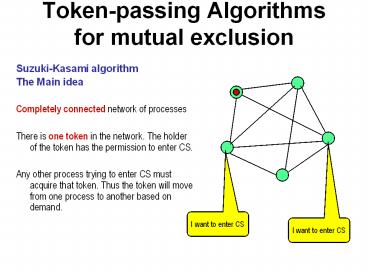Token-passing Algorithms for mutual exclusion PowerPoint PPT Presentation
Title: Token-passing Algorithms for mutual exclusion
1
Token-passing Algorithms for mutual exclusion
- Suzuki-Kasami algorithm
- The Main idea
- Completely connected network of processes
- There is one token in the network. The holder of
the token has the permission to enter CS. - Any other process trying to enter CS must acquire
that token. Thus the token will move from one
process to another based on demand.
I want to enter CS
I want to enter CS
2
Suzuki-Kasami Algorithm
req
last
- Process i broadcasts (i, num)
- Each process maintains
- -an array req reqj denotes the sequence no of
the latest request from process j - (Some requests will be stale soon)
- Additionally, the holder of the token maintains
- -an array last lastj denotes the sequence
number of the latest visit to CS from for process
j. - - a queue Q of waiting processes
req
Sequence number of the request
queue Q
req
req
req
req array0..n-1 of integer
last array 0..n-1 of integer
3
Suzuki-Kasami Algorithm
- When a process i receives a request (k, num) from
- process k, it sets reqk to max(reqk, num).
- The holder of the token
- --Completes its CS
- --Sets lasti its own num
- --Updates Q by retaining each process k only if
- 1 lastk reqk
- (This guarantees the freshness of the request)
- --Sends the token to the head of Q, along with
- the array last and the tail of Q
- In fact, token ? (Q, last)
Req array0..n-1 of integer
Last Array 0..n-1 of integer
4
Suzuki-Kasamis algorithm
- Program of process j
- Initially, ?i reqi lasti 0
- Entry protocol
- reqj reqj 1
- Send (j, reqj) to all
- Wait until token (Q, last) arrives
- Critical Section
- Exit protocol
- lastj reqj
- ?k ? j k ? Q ? reqk lastk 1 ? append k
to Q - if Q is not empty ? send (tail-of-Q, last) to
head-of-Q fi - Upon receiving a request (k, num)
- reqk max(reqk, num)
5
Example
req1,0,0,0,0
req1,0,0,0,0 last0,0,0,0,0
1
0
2
req1,0,0,0,0
4
req1,0,0,0,0
3
req1,0,0,0,0
initial state process 0 has sent a request to
all, and grabbed the token
6
Example
req1,1,1,0,0
req1,1,1,0,0 last0,0,0,0,0
1
0
2
req1,1,1,0,0
4
req1,1,1,0,0
3
req1,1,1,0,0
1 2 send requests to enter CS
7
Example
req1,1,1,0,0
req1,1,1,0,0 last1,0,0,0,0 Q(1,2)
1
0
2
req1,1,1,0,0
4
req1,1,1,0,0
3
req1,1,1,0,0
0 prepares to exit CS
8
Example
req1,1,1,0,0 last1,0,0,0,0 Q(2)
req1,1,1,0,0
1
0
2
req1,1,1,0,0
4
req1,1,1,0,0
3
req1,1,1,0,0
0 passes token (Q and last) to 1
9
Example
req2,1,1,1,0 last1,0,0,0,0 Q(2,0,3)
req2,1,1,1,0
1
0
2
req2,1,1,1,0
4
req2,1,1,1,0
3
req2,1,1,1,0
0 and 3 send requests
10
Example
req2,1,1,1,0
req2,1,1,1,0
1
0
2
req2,1,1,1,0 last1,1,0,0,0 Q(0,3)
4
req2,1,1,1,0
3
req2,1,1,1,0
1 sends token to 2
11
Raymonds tree-based algorithm
1
4
1
4,7
1,4
1,4,7 want to enter their CS
12
Raymonds Algorithm
1
4
1,4
4,7
2 sends the token to 6
13
Raymonds Algorithm
4
4
These two directed edges will reverse their
direction
4
4,7
6 forwards the token to 1
The message complexity is O(diameter) of the
tree. Extensive empirical measurements show that
the average diameter of randomly chosen trees of
size n is O(log n). Therefore, the authors claim
that the average message complexity is O(log n)
14
Distributed Snapshot
15
Distributed snapshot
- -- How many messages are in transit
- on the internet?
- -- What is the global state of a distributed
system of N processes? - How do we compute these?
16
Think about these
- -- How many messages are in transit
- on the internet?
- -- What is the global state of a distributed
system of N processes? - How do we compute these?
17
One-dollar bank
Let a 1 coin circulate in a network of a million
banks. How can someone count the total in
circulation? If not counted properly, then one
may think the total in circulation to be one
million.
18
Importance of snapshots
- Major uses in
- - deadlock detection
- - termination detection
- - rollback recovery
- - global predicate computation
19
Consistent cut
A cut is a set of events.
- (a ? consistent cut C) ? (b happened before
a) ? b ? C - If this is not true, then the cut is inconsistent
b
g
c
time
a
d
P1
e
m
f
P2
P3
k
h
i
j
Cut 1
Cut 2
(Not consistent)
(Consistent)
20
Consistent snapshot
- The set of states immediately following the
events (actions) in a consistent cut forms a
consistent snapshot of a distributed system. - A snapshot that is of practical interest is the
most recent one. Let C1 and C2 be two consistent
cuts and C1 ? C2. Then C2 is more recent than C1. - Analyze why certain cuts in the one-dollar bank
are inconsistent.
21
Consistent snapshot
- How to record a consistent snapshot? Note that
- 1. The recording must be non-invasive.
- 2. Recording must be done on-the-fly.
- You cannot stop the system.

